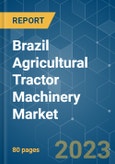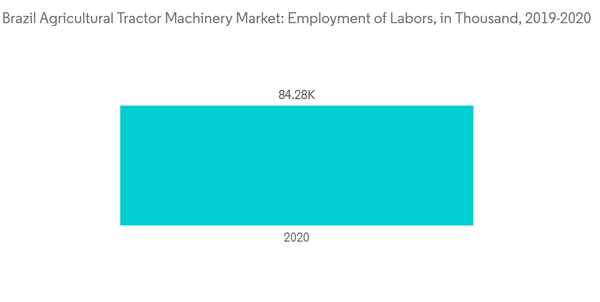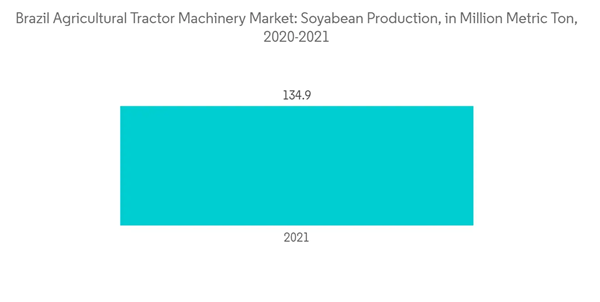The Brazil Agricultural Tractor Machinery Market is projected to register a CAGR of 3.9% during the forecast period.
Moreover, governments in a number of developing nations are providing subsidies and financial aid to help with the automation of key agricultural processes. Furthermore, as a result of different technical breakthroughs, modern tractors with pre-installed GPS and telematics systems have emerged. The global agriculture tractor market is likely to be driven by the rising popularity of automated tractors, as well as the widespread use of wireless connectivity for remote monitoring, which can be used for agriculture purposes.
Due to technological breakthroughs that are altering farming and agricultural processes, the industry is also gaining attraction. Agricultural tractors with self-driving capabilities are projected to boost productivity and efficiency in the industry. CNH Industrial NV, Escorts Limited, and Deere and Company have all already released concepts for autonomous and electrified tractors.
With the increasing unavailability of farm laborers and the growing mechanization of agriculture, the demand for row-crop tractors boosts the sales of the market. The increasing demand for power, precision, handling, and efficiency has shaped the development of the modern planter tractor, and it continues to drive the development of these tractors.
Due to the continuous demand and rising sales growth, in the year 2020, Deere & Company launched a new 8 Family Tractor line-up that includes 8R wheel tractors, 8RT two-track tractors, and the industry’s first fixed-frame four-track tractors. These new tractors come standard equipped with the latest precision agriculture technology and allow customers to choose the machine configuration, options, and horsepower to best fit their operation.
This product will be delivered within 2 business days.
Key Highlights
- Agribusiness is one of the main activities in Brazil and contributes significantly to the Brazilian economy. This has led to more investments, leading to the growth of the market of agricultural machinery and implements in the country. The increasing wage of labor and the growing land consolidation created a demand for agricultural mechanization and the Brazilian government's schemes and initiatives to facilitate financing and improve agricultural-related activities which are expected to boost the sales of tractors.
- Brazil is the second largest exporter of agricultural products globally, behind only the United States. Due to advancements in agricultural technology that benefit farmers all over the world, Brazilian farmers today are creating thriving agricultural operations on land that was considered agriculturally useless for hundreds of years. In addition, these operations are more productive, allowing for more harvest, and using less land.
- In Brazil, resource costs for farming are low relative to that of competitors largely because of lower land and capital costs, making it easier to expand acreage and increase productivity. Growth in production has exceeded growth in domestic consumer demand, leaving surplus production for more exports. The value of Brazil’s agricultural exports in 2021 reached USD 125 billion, led by soybeans and soybean meal, sugar, beef, poultry, corn, cotton, pork, coffee, and citrus. Soaring demand from China has been at the root of much of Brazil’s export growth. In 2021, China accounted for 39 percent of Brazil’s total agricultural exports and 70 percent of the total volume of Brazil’s soybean exports.
Brazil Agricultural Tractor Machinery Market Trends
Labor Shortage Resulting in Farm Mechanization
Farming has traditionally been a highly-labor intensive method in Brazilian agriculture. But the continually rising real wage of farm labor has positively impacted the demand for tractors in the region, as farmers are increasingly adopting agricultural mechanization including tractors as a substitute for manual labor. According to the World Bank database, the employment in agriculture out of total employment in Brazil stood at 9.4% in 2021, as opposed to 9.39% in 2018. Moreover, the average hourly real wage for nonsupervisory hired farm workers has increased over the last few years, which has further instigated the demand for tractors in the country.Moreover, governments in a number of developing nations are providing subsidies and financial aid to help with the automation of key agricultural processes. Furthermore, as a result of different technical breakthroughs, modern tractors with pre-installed GPS and telematics systems have emerged. The global agriculture tractor market is likely to be driven by the rising popularity of automated tractors, as well as the widespread use of wireless connectivity for remote monitoring, which can be used for agriculture purposes.
Due to technological breakthroughs that are altering farming and agricultural processes, the industry is also gaining attraction. Agricultural tractors with self-driving capabilities are projected to boost productivity and efficiency in the industry. CNH Industrial NV, Escorts Limited, and Deere and Company have all already released concepts for autonomous and electrified tractors.
Row Crop Tractors Dominate the Market
Brazil is the largest country in terms of arable land and one of the top producers of 34 agricultural commodities, and the largest agricultural net exporter. Manual plowing, harvesting, and other operations are found to be unfeasible and time-consuming. This has led farmers to opt for tractors and other types of machinery to address the challenges, such as cost, accuracy, and shortage of labor. The row-crop tractor is specifically tailored to grow crops that meet all agricultural demands, such as plowing, harrowing, leveling, pulling seed drills, weed control, and running various machines, like water pumps and belt pulley threshers. These tractors are provided with replaceable driving wheels of different tread widths.With the increasing unavailability of farm laborers and the growing mechanization of agriculture, the demand for row-crop tractors boosts the sales of the market. The increasing demand for power, precision, handling, and efficiency has shaped the development of the modern planter tractor, and it continues to drive the development of these tractors.
Due to the continuous demand and rising sales growth, in the year 2020, Deere & Company launched a new 8 Family Tractor line-up that includes 8R wheel tractors, 8RT two-track tractors, and the industry’s first fixed-frame four-track tractors. These new tractors come standard equipped with the latest precision agriculture technology and allow customers to choose the machine configuration, options, and horsepower to best fit their operation.
Brazil Agricultural Tractor Machinery Industry Overview
The Brazil Agricultural Tractor Machinery Market is consolidated and is dominated by global manufacturers since farmers prefer international companies for assurance of quality and after-sales services offered by the big companies. The key players in the market are AGCO Corporation, CNH Industrial, Deere and Company, Kubota Agriculture Machinery, Mahindra and Mahindra Ltd. New product launches, partnerships, and acquisitions are the major strategies adopted by the leading companies in the market in the country. Along with innovations and expansions, investments in R&D and developing novel product portfolios will likely be crucial strategies in the coming years. These companies are making strategic partnerships with domestic companies to expand their distribution network and launch new innovative tractors that cater to the needs of the farmers in this region.Additional Benefits:
- The market estimate (ME) sheet in Excel format
- 3 months of analyst support
This product will be delivered within 2 business days.
Table of Contents
1 INTRODUCTION
4 MARKET DYNAMICS
5 MARKET SEGMENTATION
6 COMPETITIVE LANDSCAPE
Companies Mentioned (Partial List)
A selection of companies mentioned in this report includes, but is not limited to:
- AGCO do Brasil
- John Deere Brasil Ltda
- CNH Industrial Brasil Ltda
- Mahindra & Mahindra Ltd
- Kubota Agricultural Machinery
- Tractors and Farm Equipment Limited (TAFE)
- Escorts Limited
- Kuhn
- Claas KGaA mbH
- New Holland Agriculture
Methodology

LOADING...










